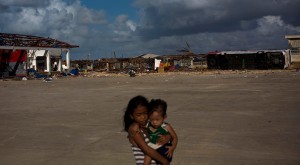Guiuan folk: How shall we live?

Typhoon Haiyan survivors walk at the destroyed port in the town of Guiuan, Eastern Samar, Friday, Nov. 15, 2013. AP FILE PHOTO
GUIUAN, Philippines – Fleeing to higher ground was not enough to save dozens of residents of this town last November 8 when Supertyphoon “Yolanda” (international name Haiyan) brought angry winds, peeling off sheets of corrugated metal from houses and buildings and uprooting thousands of coconut trees.
Packing maximum sustained winds of 235 kilometers per hour (315 kph according to the US Navy’s Joint Typhoon Warning Center), the typhoon’s winds alone obliterated houses made of light material and toppled concrete foundations. In areas hit by the storm surge, the entire villages were washed out, with many residents killed.
“It was like a tornado,” residents would tell INQUIRER.net two weeks later.
Remedios Acal said the day before the typhoon hit, their family left their fishing village and sought refuge in the town gym. But even before “Yolanda” made its landfall, the structure collapsed.
“It was around midnight when I woke up…because of the strong rain and wind. I saw parts of the roof being torn off by the wind, some falling inside the gym,” she said, brows furrowed while remembering the eventful night.
Article continues after this advertisement“That was when we panicked.”
Article continues after this advertisementAt least 60 people rushed to the exit but it was closed and could not be opened because of the fallen debris.
“We could see the walls shaking, swaying like curtains,” she said. “I thought, ‘Lord, let this not be our end.’ I was carrying an angel, a two-month old baby.”
Thinking of the safety of the baby that was in her arms, she pleaded with the men to force the door open.
“A young man named Elmer saved us…One by one we (passed through the small opening of the door),” Acal said.
Their group could do nothing but stay beside the gym’s wall which protected them from flying debris.
In the school where Acal was now staying in, evacuees said they watched in horror as the wind stripped the second floor of its roof and glass. They said large pieces of metal swirled in the wind as they ran to the ground floor.
Although relatively safe from the collapsing structure of the gym, Acal became worried about the rest of her family that got separated from them. She prayed, hoping no one would be harmed.
When morning came, she was reunited with her daughter and her husband who was wounded in the head and the back.
“A piece of wood fell on his head. Meanwhile, his shoulder was pummeled by concrete [as the gym collapsed]. When he regained consciousness, he managed to crawl out,” she said.
With all of her three children accounted for, their group sought help. They found their good Samaritan in the woman who was her child’s high school teacher.
Acal said the teacher let them stay in her house and even fed the children lugaw (porridge).
“We were so many, it was a little embarrassing. Halos isang barangay kami magkakasama (It was like a village). I helped cleanup…even if I was not able to eat,” she said.
It was only after her children were fed and settled that she took her husband, whose wounds were still bleeding, to the local doctor.
Looking back, she said they were lucky to be alive, unlike others killed by the storm surge or falling debris.
More than two weeks after “Yolanda” devastated Guiuan, residents are still living in evacuation centers.
Acal said their village was completely destroyed but they will need to return there soon because the school they are staying in will have to be repaired and opened for classes.
“We’ll have to build a new home because we don’t own land…barong-barong muna (makeshift house would do),” she said, adding that their old house was on government land.
But her family is more concerned of what awaits them after relief goods run out.
“Wala po kaming inaasahan na kabuhayan (We’ve no more source of livelihood),” she said.
Like many survivors, her husband lost his fishing boat to the typhoon.
They also have to contend with supposedly unfair treatment when it comes to the distribution of relief goods.
Acal said village officials gave more goods to people close to them.
“It is unfair because in our area, in Barangay (village) 6, the relief packs contain six kilos of rice, 10 cans of sardines, 10 packs of noodles, sugar and other items. But we only received 3 kilos of rice and 3 cans of sardines,” she said.
Guiuan Vice Mayor Rogel Cablao dismissed such claims, saying relief packs vary because of the different donor organizations.
At the municipal hall, windows were shattered and rain water flooded the second floor.
Cablao gestured at the handwritten notes on the wall, showing INQUIRER.net their tally of deaths and assistance received. At that time, the death toll was at 99, with most of the victims from villages hit by the storm surge.
The vice mayor said the number would have been higher had they not facilitated pre-emptive evacuation.
Weeks after the typhoon, they would have to address the widespread devastation suffered by the town.
Our evacuation centers, schools, hospitals and other infrastructure were heavily damaged, he said. Majority of the people in Guiuan also lost their livelihood after motor boats and coconut trees were destroyed.
Cablao said they were fortunate that they had an airport which now serves as the operation and distribution center of relief goods in Eastern Samar.
Read: US forces start pullout from typhoon-hit areas in Eastern Samar
Related Stories:
Guiuan ready to bounce back, looks for alternative jobs
US forces start pullout from typhoon-hit areas in Eastern Samar
Guiuan townsfolk still hope for flights
Guiuan grocer forgives looters